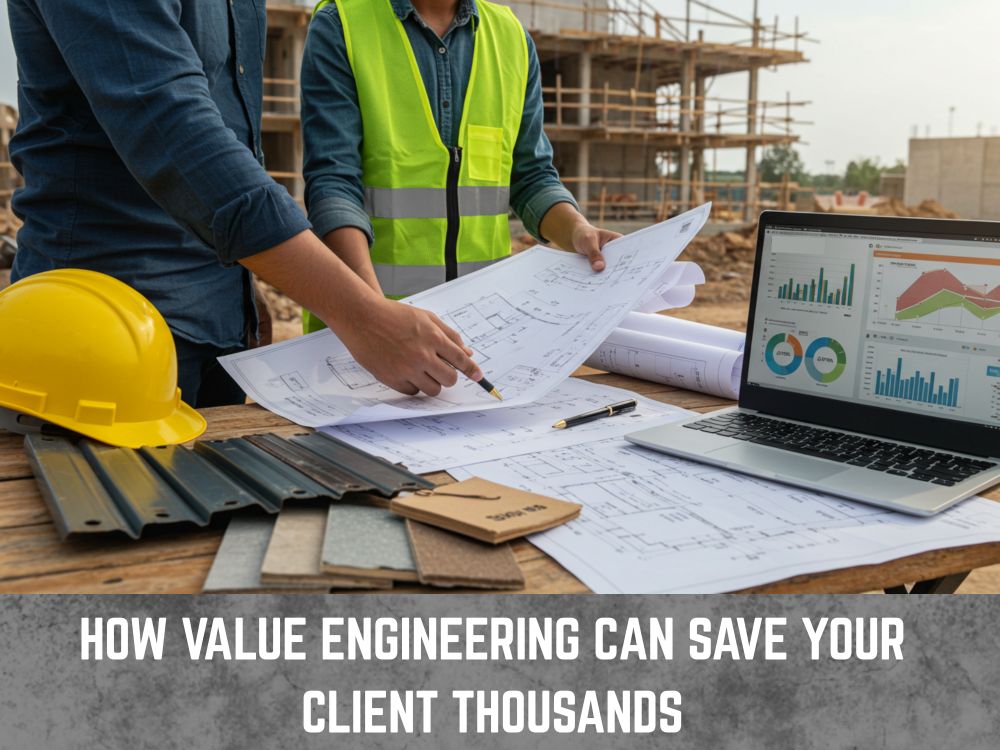In the construction industry, the term “cost-cutting” often brings to mind a reduction in quality or a compromise on the project’s original vision. This is a common misconception, and it’s precisely why smart contractors and their clients are turning to a more sophisticated strategy: Value Engineering (VE).
Value Engineering is not about cheapening a project. It’s a systematic and organized approach to analyzing a building’s design, materials, and methods to achieve the essential functions at the lowest possible cost without sacrificing quality, performance, or reliability. In essence, it’s about delivering more value for less money. By applying this proactive process, you can save your client thousands of dollars and build a reputation as a trusted, innovative partner.
What Is the Difference? Cost-Cutting vs. Value Engineering
Understanding the distinction between these two concepts is crucial for a contractor.
Cost-Cutting: This is a reactive measure, often implemented late in the project when the budget is already tight. It typically involves simply removing features or downgrading materials to lower the price. A cost-cutting solution might be swapping a high-quality, durable flooring for a cheaper, less resilient alternative. The result is a cheaper project, but with reduced long-term value and functionality.
Value Engineering: This is a proactive process that begins in the early design phases. It’s a collaborative effort between the owner, architect, engineers, and contractor. The goal is to innovate and find alternative solutions that meet or exceed the original functional requirements at a lower cost. A VE solution might be redesigning a building’s HVAC system to be more energy-efficient and less expensive to operate over its lifetime, or finding a more efficient way to frame the structure that uses less material without compromising strength.
The 5-Step Value Engineering Process
A successful Value Engineering exercise follows a structured, logical methodology.
Step 1: Information Gathering
This initial phase is about understanding the project’s core objectives. The team gathers all relevant documents—blueprints, specifications, and project goals. The central question is: “What is the function of each component?” This helps to separate a component’s “must-have” functions from its “nice-to-have” features. For example, the function of a wall is to provide structural support and enclose a space; its aesthetic function is secondary to its primary purpose.
Step 2: Creative & Speculative Phase
This is the brainstorming session where the team generates as many ideas as possible for each component. No idea is too outlandish at this stage. The goal is to think outside the box and find alternative ways to perform the same function. This is where innovation happens. A contractor might suggest a pre-fabricated wall system instead of traditional on-site construction to reduce labor costs and build time.
Step 3: Analysis & Evaluation
Once ideas are generated, the team evaluates each one based on its potential cost savings, feasibility, and impact on quality. A matrix is often used to score each idea. For example, a suggestion to use a different type of roofing material might be evaluated on its initial cost, long-term durability, installation time, and its impact on the building’s aesthetic.
Step 4: Development & Recommendation
The most promising ideas from the analysis phase are developed into detailed proposals. This includes a clear description of the proposed change, a detailed cost-benefit analysis, and any potential impacts on the project schedule. The recommendations are then presented to the client for approval.
Step 5: Implementation
Once a Value Engineering proposal is approved, it is integrated into the project plan. The contractor then oversees the implementation, ensuring that the new solution is executed correctly and that the projected savings are realized.
Real-World Examples of Value Engineering
Value Engineering can be applied to virtually every aspect of a construction project. Here are a few common examples:
- Materials: Suggesting a more cost-effective but equally durable concrete mix for a foundation, or using a less expensive but code-compliant piping material for a plumbing system.
- Design: Proposing a minor re-alignment of a building’s footprint to reduce excavation costs, or optimizing the layout of walls to use standard lumber sizes, minimizing waste.
- Methodology: Recommending a different construction sequence to reduce the amount of time and labor required, such as using pre-assembled components rather than building from scratch on-site.
- Energy Efficiency: Proposing high-performance lighting systems that have a higher initial cost but save thousands of dollars in energy bills over the project’s lifetime.
The Contractor’s Advantage
By proactively engaging in Value Engineering, a contractor can achieve a significant competitive advantage.
- Builds Trust: When you present solutions that save a client money without compromising their vision, you become a trusted advisor, not just a service provider.
- Wins More Bids: Offering a Value Engineering proposal as part of your bid shows a commitment to your client’s financial success and sets you apart from competitors.
- Increases Profitability: A well-executed VE proposal often includes a percentage of the savings as a bonus for the contractor, rewarding your innovation and expertise.
- Mitigates Risk: VE can identify and mitigate potential risks early in the process, such as material availability issues or costly design flaws.
Value Engineering is the smart way to build. It transforms the conversation from one of painful cuts to one of strategic innovation, ensuring that every project delivers maximum value to the client while securing a more profitable future for your business.


